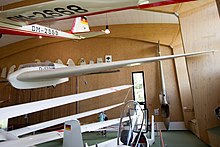Hoarding Ho 33
| Hoarding Ho 33 | |
|---|---|

|
|
| Type: | Sport plane |
| Design country: | |
| Manufacturer: |
Alfons Pützer Kg |
| First flight: |
1954 (no drive) March 26, 1957 (motorized) |
| Number of pieces: |
2 |
The Horten Ho 33 is a sport aircraft made by the German manufacturer Gebrüder Horten .
history
When it became possible to build gliders again in Germany in 1951, Walter Horten, who had remained in Germany, began to construct a flying wing called the Horten Ho 33 based on the Horten H III.It was built from 1953 by Alfons Pützer KG in Bonn . The aircraft was initially built as a glider due to the still valid construction ban for motorized aircraft , the first unpowered flight took place in 1954. The engine and provisional traffic approval (code: D-EJUS) was carried out by the Aviation Science Association Aachen 1920 eV (FVA ) under the project name FVA-17. For this, the machine was around Christmas 1955 to at Aachen lying Merzbrück Airport transferred. A four-cylinder in - line Zündapp Z9-092 engine with 37 kW with a pusher propeller was provided. It was not until March 26, 1957 that the first powered flight with the pilot Hommes on board could be carried out. Just three years later, the aircraft, which had become much too heavy due to the modifications, had to be scrapped due to faults in the casein gluing.
A second model with Kaurit glueing and a Porsche PFM 678/0 engine with 48 kW was built as early as 1955 (D-EGOL code). The first flight took place on September 28, 1955 in Bonn-Hangelar with Johnny Müller at the wheel. In June 1956 the machine was converted to the more powerful PFM 678/4 with 55 kW. Today the machine belongs to the German Glider Museum on the Wasserkuppe and has been dismantled there with some changes to the glider V1. Despite its good flight performance, the machine turned out to be unwieldy due to its large wingspan, too sensitive to taxi and, at 18,000 DM, too expensive, so that Horten and Pützer decided against series production.
construction
The Horten Ho 33 is a flying wing with four-wheel undercarriage, in which two main wheels placed one behind the other in the fuselage (the rear one was controllable) are supported by two support wheels in the wings. It was designed as a powered airplane with good gliding characteristics. The engine was installed behind the seats and drove a pusher propeller via a 92 cm long remote shaft. Zundapp, Continental and Porsche engines between 45 and 85 hp were planned as drive, with Horten also planning the installation of a much more powerful Turbomeca Palas turbine . The single-spar wing was made of wood with a torsion nose. Combined ailerons and elevators as well as special flaps were used on the outer wings for control purposes, which were knocked out as a resistance surface for rudder control upwards. Like the wing, the fuselage was made of wood with two seats in a row.
Technical specifications
| Parameter | Data |
|---|---|
| crew | 1 |
| Passengers | 1 |
| length | 4.85 m |
| span | 19.20 m |
| height | 2.00 m |
| Wing area | 35.6 m² |
| Glide ratio | 26 at 90 km / h |
| Empty mass | 460 kg |
| Max. Takeoff mass | 650 kg |
| Cruising speed | 150 km / h |
| Top speed | 172 km / h (max. Permitted 240 km / h) |
| Engines | a Porsche PFM 678/3 with 52 hp |
See also
Web links
- Nurflügel.com: Horten Ho 33
- LuftArchiv.de: Hoarding
Individual evidence
- ↑ Rudolf Storck: Flying WIngs , Bernard & Graefe Verlag, 2003, p 97
- ↑ Wasserkuppe glider club: Pützer Horten Ho 33 V1 ( Memento of the original from September 24, 2015 in the Internet Archive ) Info: The archive link has been inserted automatically and has not yet been checked. Please check the original and archive link according to the instructions and then remove this notice.
- ↑ FliegerRevue, January 2011, pp. 56–59, back print
- ↑ a b Rolf Wurster, 50 years of German motor aircraft , p. 25ff
- ↑ FVA: FVA-17 "Flying wing"
